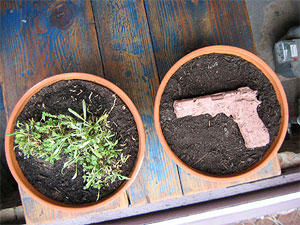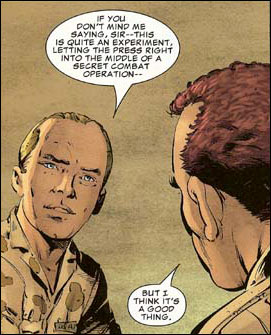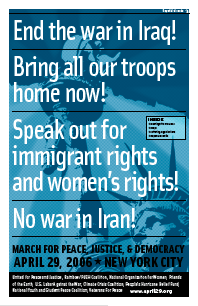iraq
War and Peas
Along the lines of this NY Times infographic on the enormous opportunity cost of the Iraq war (say... universal health care in the U.S. — twice over), my friend Noah has packaged a more experiential approach: plantable firearms made of clay, compost, and a mix of seeds. Walk through the manufacturing process at this Flash photo gallery or order one of your own. (via, via)
3,000
Mapping the “War on Terror,” 2
The Privatization of War: Colombia as Laboratory and Iraq as Large-Scale Application is a mapping project by artist Lize Mogel and writer Dario Azzellini, on display at the Gwangju Bienniale in South Korea.
The 50 foot long mural diagrams the relationships between the United States and private military contractors and their activities in Colombia and Iraq. These corporations are less accountable to Congress and the public, and provide “products” and services including:
“risk advisory, training of local forces, armed site security, cash transport, intelligence services, workplace and building security, war zone security needs, weapons procurement, personnel and budget vetting, armed support, air support, logistical support, maritime security, cyber security, weapons destruction, prisons, surveillance, psychological warfare, propaganda tactics, covert operations, close protection and investigations.” [source]
Read more about the project and see a larger image of the map here.
Mapping the “War on Terror,” 1
The NYC Guide to War Profiteers
First blogged here in August 2004, the NYC Guide to War Profiteers has fallen off the Web. The site of the March 27 Coalition that quckly came together in 2003 has since lapsed into the hands of domain squatters.
A friend recently inquired about the map, so I scanned my hard copy and am posting it here.
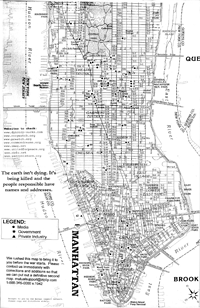 Front, 787 Kb PNG, 150 dpi |
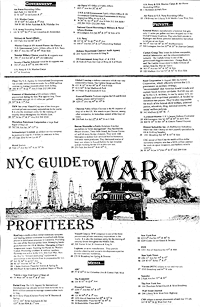 Back, 681 Kb PNG, 150 dpi |
The map was assembled by the “mutual support network” and rushed to press just before the invasion of Iraq in March 2003.
The map has a low-tech, DIY aesthetic, designed to be reproduced by photocopy on the front and back of a standard sheet paper. The icons are composed of cut paper, arranged on a found map. The map was available at progressive bookstores around town, and was distributed at organizing meetings for various protest events.
The list of weapons makers, media companies, and military recruiters helped locate the discussion around the March 27, 2003 direct action. Rockefeller Center ultimately was chosen for its proximity to several points on the map.
Three years later, the map has not lost its relevance.
Domestic Policy
Another item I missed while out, on May 24, President Bush appointed Karl Zinsmeister as his chief domestic policy advisor (replacing Claude Allen who resigned in February when caught stealing from Target.) Judging from the appointment, the domestic agenda seems more about propaganda than poverty.
His qualifications? Zinsmeister was editor of The American Enterprise, the magazine of the American Enterprise Institute, a neo-conservative think tank whose stated mission is to support the “foundations of freedom — limited government, private enterprise, vital cultural and political institutions, and a strong foreign policy and national defense.” Among the organization’s funders are both Microsoft and the Scaife family.
Also on his resume, in 2003, Zinsmeister was embedded as a military reporter with the 82nd Airborne in Iraq. His Iraq experience is chronicled in Combat Zone: True Tales of GI’s in Iraq, which Zinsmeister wrote for Marvel Comics. [source] The comic excludes accounts of torture and detainee abuse by the 82nd Airborne later documented by Human Rights Watch.
Further qualifying him, is Zinsmeister’s 2002 essay When Art Becomes Inhuman, a critique of modern art, liberals, and, of course, Manhattan. [source]. His rant against abstraction is an ironic reversal from the days when the CIA helped promote abstract expressionism at the expense of social realism to keep the Commies at bay. Nowadays, with abstraction duly en-framed in the canon of modern art, it makes easy fodder for the ‘liberals are elitist snobs’ line of right-wing populists.
Among his accusations, is one about lefty directors of musical theater who “believe audiences should absorb ideological messages in the theater, not beautiful songs.” This is of course coming from his own ideological screed. But it’s also a further note of just how ideological the apparent ‘invisibility’ and ‘neutrality’ of beauty really is.
March in April
This Saturday, April 29, we take to the streets to end the war in Iraq, support immigrant rights and women’s rights, and to oppose war against Iran. I designed a broadsheet that the organizing coalition will distribute. It’s a two-color, tabloid-sized, eight-page booklet in English and Spanish with statements by the organizers, emergency contact info, and maps of the affinity group assembly areas, march route, and peace festival.
It was a challenge giving the different messages equal weight without flattening out the design. Because of the politics of the coalition, this was a big requirement. It was also my first chance to play with the City’s official NYCMAP data, which was fun. The cover image extends the Statue of Liberty image used in the existing flyers, but pushes it back to make it a little more ambient and less iconographic. It was a rush job and stepping back, some of the type treatment feels a little heavy-handed. But I’m otherwise pleased with it. We’ll see how it works on newsprint. Maybe the heaviness is appropriate.
Up in Smoke
Back in November 2004, a portrait of a U.S. Marine in Iraq rapidly became an icon of weary, insouciant toughness and cool that so many love in their cinematic heros.
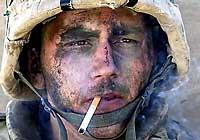 Patrick J. McDonnell wrote in the Los Angeles Times:
Patrick J. McDonnell wrote in the Los Angeles Times:
A smoke break creates icon of the war; now groupies seek out the weary Marine
“Miller is the young man whose gritty, war-hardened portrait, shot by Luis Sinco, a Los Angeles Times photographer, appeared Wednesday in more than 100 U.S. newspapers, including The Seattle Times. In the full-frame photo, taken after more than 12 hours of nearly nonstop deadly combat, Miller’s camouflage war paint is smudged. He sports a bloody nick on his nose. His helmet and chin strap frame a weary expression that seems to convey the timeless fatigue of battle. And there is the cigarette, of course, drooping from the right side of his mouth in a jaunty manner that Humphrey Bogart would have approved of. Wispy smoke drifts off to his left.
The image has quickly moved into the realm of the iconic.
More than 100 newspapers printed it, although it took the New York Post to sum it up in a front-page headline: ‘Marlboro Men Kick Butt in Fallujah.’ The fact that Miller’s name was not included in the caption material only seemed to enhance its punch....
The photo was taken on the afternoon after Charlie Company’s harrowing entry into Fallujah under intense enemy fire, in the cold and rain. Miller was on the roof of a home where he and his fellow First Platoon members had spent the day engaged in practically nonstop firefights, fending off snipers and attackers who rushed the building. No one had slept in more than 24 hours. All were physically and emotionally drained.”
See this previous post on Bag News Notes for further analysis of the Times article and photo.
See also Human Rights Watch‘s report on Charlie Company‘s earlier seige and occupation of Fallujah.
Today, however, we learn from Editor and Publisher that:
‘Marlboro Man’ in Iraq War Photo Suffers from PTSD
Back home, he got married in June, but on duty during the Hurricane Katrina relief effort, Miller suffered from symptoms of post-traumatic stress disorder (PTSD), and was granted an honorable discharge from the Marines in November....
Miller went into therapy, but knows he is not alone. ‘A lot of guys have had way worse incidents from being in Iraq,’ he said. ‘And I guess it just -- it troubled me due to the fact that their incidents may have been more severe, and they weren’t suffering from the same things I was. I just didn’t understand how it could affect me so dramatically and not affect some of these guys. But a lot of them deal with different ways.
‘The more and more I talk to [other guys], the more I found out there were a lot of Marines that are going through same or similar emotions. It’s tough to deal with. Being in Iraq is something no one wants to talk about.’”
Quickies
Danish anti-war posters hit Iraq:
“On Friday, Iraqis started hanging over 1000 posters created by the artists in the most populous and important quarters of the capital, including the diplomatic Green Zone in the very heart of the city. Artist Claus Rohland, 50, explained to Aljazeera.net why he and fellow artist Jan Egesborg, 40, had got involved and what message they hoped to send to ordinary Iraqis.... ‘We as Danes are part of this so-called coalition and are taking part in this war. But Denmark is a very small country that has not been at war for many years. We need to question what we are doing and what is happening,’ Rohland said. ‘None of the warring parties — neither US-led forces nor Iraqi rebels — present a solution to this war. The ultimate solution needs to come from ordinary people. It may sound naive, but we would encourage people to keep faith in themselves that a final solution rests with them.’”
---
North Dakota has no plans to alter Sioux logo:
“The NCAA considers the logo and nickname ‘hostile and abusive,’ and has ordered the school to cover up all Fighting Sioux references for the NCAA playoffs. The arena, which operates separately from the school, is holding the West Regional hockey tournament in March. [Jody Hodgson, arena manager,] said there are no plans to alter any logos, which can be found on floors, walls, seats and railings. Eliminating them would be too expensive, he said.”
---
Electronics industry urges federal e-waste action:
“A nine-member panel appearing before the U.S. House of Representatives subcommittee on environment and hazardous materials expressed concern that the current trend of varied state and local laws targeting e-waste management would breed inefficiency, confusion and higher prices for consumers.... The best approach, [Renee St. Denis of Hewlett-Packard] said, is for federal lawmakers to create a system in which the manufacturers themselves set up recycling programs and bear the necessary costs.”
---
Deal for Public Toilets in New York City. Only 20 toilets, but it’s a start. The winning company will rebuild all city newsstands and bus shelters, too — and sell the ad space. Not sure how I feel about a private corporation owning all that public space — but then the NYC gov pays nothing. More on the the long history of trying to build public toilets in NYC here and here.
---
Alcaldía favorece proyecto de biogas. Nicaragua’s biggest garbage dump in the Barrio La Chureca in Managua could be used to create enough electricity to illuminate the nearby municipality of Ciudad Sandino. The joint U.S.-Nicaraguan company Conjuris says they can create four megawatts of electrical energy from the gases emitted by burning the garbage. The company is willing to invest US$5.25 million in the project in return for a twenty year contract.
---
It’s great to see graphic designers come together at displaceddesigner.com, the AIGA, and Design Observer to help other graphic designers affected by Hurricane Katrina. I’m all for community and solidarity. But then it’s really not the professional designers that are hurting the most, no?
---
Only one more month until the October 31 deadline to submit your radical graphics to Reproduce & Revolt. And it looks like Favianna has joined the project!
Support Our Tropes, 2

It’s a funny thing to see all the flag waving conflated with the whole “support the troops” message today. I support the troops plenty, though not this stupid war. But then what exactly do the troops have to do with the fourth of July? I mean, today is Independence Day! The day we celebrate the American Revolution, when a plucky, unorganized group of armed radicals defeated the professional military of a foreign occupation. A victory for automony over empire! In Iraq, aren’t the U.S. troops a lot closer ye olde army of King George?
American Graffiti
In January 1991, George Lakoff published Metaphor and War: The Metaphor System Used to Justify War in the Gulf. He showed the discourse of war as ‘a panorama of metaphor,’ documenting, for instance, the state-as-person metaphor “engaging in social relations within a world community.” It’s health is economic health. It’s well-being is wealth. And its strength is military strength.
“War in this metaphor is a fight between two people, a form of hand-to-hand combat. Thus, the US sought to ‘push Iraq back out of Kuwait’ or ‘deal the enemy a heavy blow,’ or ‘deliver a knockout punch.’ A just war is thus a form of combat for the purpose of settling moral accounts....
The fairy tale has an asymmetry built into it. The hero is moral and courageous, while the villain is amoral and vicious. The hero is rational, but though the villain may be cunning and calculating, he cannot be reasoned with. Heroes thus cannot negotiate with villains; they must defeat them. The enemy-as-demon metaphor arises as a consequence of the fact that we understand what a just war is in terms of this fairy tale.
The most natural way to justify a war on moral grounds is to fit this fairy tale structure to a given situation. This is done by metaphorical definition, that is, by answering the questions: Who is the victim? Who is the villain? Who is the hero? What is the crime? What counts as victory? Each set of answers provides a different filled-out scenario.”
There is, of course, no room in these stories for the horror of war or the possibility of popular dissent.
In March 2003, on the eve of the second invasion, Lakoff published Metaphor and War, Again, charting again how the state-as-person continued to circulate. Added to this is the Rescue Scenario in which W. saves the Iraqi people and Saddam’s neighbors, whom he is “threatening.”
While Lakoff shows how metaphors help form conceptual frames that explain and justify military action, Yusuf Progler shows how these are rendered literal in blood and steel — inscribed onto the machinery itself.
From January 1999, Racist and degrading graffiti rooted in America's military culture:
During the last hours of ‘Operation Desert Fox,’ the murderous Anglo-American pre-Ramadan assault on the Muslim population of Iraq, the Associated Press broadcast a photograph of a US Navy missile ‘festooned with disparaging graffiti.’ Subsequent news reports mentioned one of the ‘several inscriptions’ scrawled on the missile: ‘Here’s a Ramadan present from Chad Rickenberg.’
Almost immediately, the offensive graffiti was strategically denounced by Pentagon officials as a ‘rare exception.’ In a statement released to the press, the Pentagon stressed that the graffiti ‘does not reflect American policy’ toward Muslims, adding that the US appreciates the ‘important contributions of Muslim-Americans to the US military.’ But despite the official denial, and though it received no further media attention, the incident is symptomatic of a long-standing legacy.
Aside from the reality that ‘American policy’ toward Muslims has included bombing and starving Iraq into oblivion, letting Bosnians be murdered and raped by Serbian fascists, supporting Israeli aggression in Palestine and Lebanon, destabilizing Iran, and attacking Somalia, Sudan, and Afghanistan, the graffiti incident is instructive in a number of ways. For one thing, it provides a rare glimpse into American military culture....
One need only look to earlier instances for verification. During ‘Desert Storm,’ the 1991 precursor to Desert Fox, reporters discovered the Anglo-American tradition of scribbling messages on bombs. Graffiti of that war ranged from adolescent silliness, such as ‘Hi Mom’ and ‘Say Cheese,’ to a range of witty puns like ‘Seasons Beatings,’ to virulently racist and sexist remarks like ‘Mrs. Saddam’s sex toy’ or ‘a suppository for Saddam.’ While British airmen are known to write messages like, ‘Dear Saddam, have a shitty day, love from the RAF,’ Americans tend to write more sexualized graffiti, with one reporter noting ‘the most identifiably American’ graffiti includes phrases like ‘bend over Saddam.’
Sometimes, US airmen write messages in their own blood. Since all of the weapons are blown to smithereens, and since the graffiti is in English, it seems obvious that the pearls of wrath and wisdom are intended for the artists themselves, almost like an inside joke, which is occasionally made public by news reports....
There’s no doubt that Chad Rickenberg, who painted a Ramadan greeting on a bomb destined to destroy Iraqis, had heard stories of similar acts committed by his predecessors in 1991, when another generation painted its degrading graffiti on bombs also destined to kill Iraqis. The oral tradition in the military passes on its rites of passage, which become badges of honor and belonging.
But such attitudes and practices toward Muslims did not emerge with the recent aggressions against Iraq and Iran. The first American military adventure against the Muslim world was initiated by then president Thomas Jefferson in the early 19th century. Those valiant exploits led to the formation of the American Navy and Marines, and the creation of a racist and phantasmagoric folklore about Muslim ‘barbarians’ and their ‘harems,’ the former to be killed and the latter to be raped. After a bit more practice on Indians and Africans, American soldiers massacred ‘Moro’ Muslims in the Philippines, America’s ‘Indian territory’ of the 1890s. Today, a century later, America’s Indian territory is Iraq. And the legacy marches on.
Indeed, this is made quite clear in this May 5, 2055 photo published on the Marine Corps own Web site. It is a photo of a U.S. tank in Iraq dubbed the ‘New Testament.’ Not only is it written across the barrel beneath the bowed head of the operator, it is highlighted in the caption:
“Haditha Dam, Al Anbar, Iraq - The ‘New Testament’ a tank with 4th Tank Co., 1st Tank battalion attached to 3/25 prepares to lead the way during a recent mission. Photo by: Cpl. Ken Melton.”
See also: Bombing Iraq, on the functions of Iraqi graffiti.



